#i need to walk into the ocean and become a plankton
Explore tagged Tumblr posts
Text
professor: so you'll be having classes from 8 to 12 every weekday and also afternoon classes from 1 to 4 around two to three days a week. and you should also plan to study for around 4 to 6 hours every day so you don't fall behind.
me: do. do you think that is a reasonable expectation to have. like do you even hear the words coming out of your mouth right now
#*screams*#*silent explosions in my mind*#somebody please put me out of my misery#this program is gonna kill me i swear#my meds barely even last a full school day and you're telling me i need to study 4 to 6 hours more after classes#this is still probably better than retail but like. good fucking lord#i need to walk into the ocean and become a plankton#college#mine#vent
2 notes
·
View notes
Text
I went to go do tashlich today and i set out bread and orthodox ashkenaz machzor in hand (the transliteration throwing me off as i flipped through), to walk to the nearest body of water, a small stream near the university chapel. It isn't really a chapel but i don't know the word to describe it. So i walk to head to the stream and as I grow closer to the stream there is a wedding, Mazel Tov i guess but i felt it would be odd to linger here so i set off elsewhere.
There was a larger pond near by but it was close to the buildings and i get self conscious davening around other people especially goyim. The other pond, was more secluded but it was the domain of the geese that i see travelling every morning to in military formation.
In the back of my mine i could hear the reprimand i had heard before about walking around in the woods on my own. (There are paths)
but then I remembered the pond! Not just any pond but one i had found in the middle of the woods somewhere.


So i wander about along the cleared paths of grass and dirt occasionally stumbling upon clearings where trees had been cut. I realize then as i quickly turn the other way that im really no different from the skittish rabbit that flees when i come near.
So i continue to wander marveling at the tall birch trees and the purple wildflowers and listen to the rustle of wind and the whine of insects that are too small to be seen but whose presence is heard. I enjoy nature. I get to witness creation. It leaves me in awe of G-D.
I had no clue where but i was determined to find it. I knew it existed i just had no clue where.
So i searched and searched and searched and almost decided to give up and return home. But i decided to try one more path. And soon i found my pond.

What caught me off guard was the colour of the water. I didn't recall the turbidity being that high.

Perhaps it was humans with chemicals that leach into the water or perhaps it was algae or plankton that has grown out of control either way it showed why Gevurah must balance Chesed.
I preform tashlich the beauty of G-D's creation in front of me. I become reminded of my hesitancy regarding my exploits
אדוני לי לא אירא, מה יעשה לי אדום
Adonai is with me, I will not fear, what can man do to me
As I cast my crumbs of bread into the waters I notice how strange it looks. Out of place. Far too human amongst the natural.
And I began to wonder if that was the point. It's supposed to be out of place. I am an environmental studies major and I have learned no matter how far you go there is very few areas that haven't been touched either with care or harm by humans. In the deepest oceans you will find plastic bags.
We hurt G-D's creation, we harm one another even though we too are part of His creation. Yet we go to the river and we cast our sins, as if we are, with heavy hearts, handing them back to Hashem by placing something so human back into the natural.
And Hashem forgives us, in turn we must strive to do better.
As humans and all life in general we can't eliminate our impacts on the world around us not necessarily good or bad but simply the result of being alive. Everything effects everything. It feels daunting. Especially when we need to repair so much.
But G-D forgives and G-D gives me hope and strength.
I'm an environmental studies and sustainability major so forgive me for my rambles.
4 notes
·
View notes
Text
Blog Post #2: Role of Environmental Interpreter.
Blog Post 2: Describe your ideal role of environmental interpreter. What might it entail? Where might it be? What skills might you need?

As a student of marine and freshwater biology, my ideal role as an environmental interpreter would center on educating people about the importance of marine ecosystems and the urgent need to conserve them. My passion for marine biology drives me to share scientific knowledge and inspire a deeper emotional connection to the ocean. I envision myself working in coastal environments, such as marine sanctuaries or aquariums, where I can combine education with advocacy for the health of our oceans.
My primary goal as an interpreter would be to create experiences that inspire people to care about marine life in a way that goes beyond just a casual interest. Whether it’s guiding a group on an underwater exploration or conducting a presentation on endangered species of the ocean, I want to help people make real, emotional connections with the marine environment. One way I might do this is by using storytelling to draw parallels between marine life and human life, highlighting how the oceans' well-being impacts the air we breathe, the food we eat, and the planet's overall health. My role wouldn’t be confined to simply providing information; it would be about motivating people to become active participants in ocean conservation efforts.

In terms of the skills I would need for this role, a deep knowledge of marine biology and ocean ecosystems is essential. Understanding the behavior, habitats, and conservation needs of species like sea turtles, dolphins, coral reefs, and even plankton would allow me to convey the intricate relationships within marine ecosystems. I’d also need to stay current on the latest marine research and conservation strategies, such as efforts to reduce plastic pollution or protect endangered species. This scientific foundation would be critical for building credibility and providing accurate, relevant information to the public. Equally important, though, would be the ability to communicate this knowledge in a way that resonates with a diverse audience. Whether I’m speaking to schoolchildren on a field trip or tourists visiting the coast, my ability to break down complex ecological concepts into clear, engaging, and actionable messages would be key. I would also want to bring in hands-on learning opportunities, like beach cleanups or citizen science projects, that empower people to make a tangible difference in marine conservation.

Overall, my vision as an environmental interpreter centers on education as a tool for change. I want people to walk away not only with a deeper understanding of marine life but also with a sense of responsibility for protecting it. If I can inspire someone to see a sea turtle, coral reef, or even a jellyfish with a newfound appreciation and spark just one person’s interest in the ocean, I will know I’ve made a meaningful impact. In a world where marine ecosystems are under increasing threat, I believe that inspiring people to care, act, and advocate for the ocean is one of the most meaningful roles I can play.
0 notes
Text
10 Breath-taking Natural Phenomena Found in the Land Down Under
Nature has so much beauty to offer and that’s evidenced by the fact that when our country went under lockdown, the only thing filling people’s Instagram feed was the clear blue skies, the vibrant green trees and a series of animal appearances that would have been otherwise left unnoticed on any given day. Man has a deep relationship with nature and anything out of the ordinary strikes us. If a day with an AQI under 100 can fill us with such joy, can you imagine what would happen if you were to witness natural beauty in all its glory? If there’s one place on this planet that can boast for some of the best natural phenomena then it’s none other than Australia. Don’t believe us? Then continue reading:
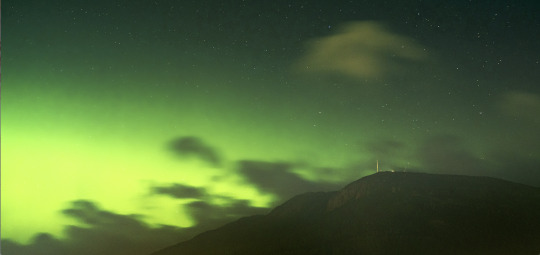
1. Bioluminescent Plankton at Jervis Bay in NSW
I bet everyone reading this article would have come across pictures of shores with blue translucent light beaming on the surface. Well, at Jervis Bay, which is a mere 3 hours away from Sydney, this phenomenon becomes a reality. Due to a natural chemical reaction within plankton, the plankton become luminescent and emanate a blue glow. This unusual natural phenomenon, which can only be seen at night can happen at any time of the year but is more common in spring and summer months when the water is warmer.
View this post on Instagram
A post shared by Australia (@australia) on Jan 16, 2020 at 7:17pm PST
2. Min Min Lights, Outback Australia, Northern Territory
The easiest way to convince people that you saw a UFO or some supernatural phenomenon is by taking a picture of the Min Min Lights. These unexplained light phenomena literally will stalk you. Described by witnesses as floating, fast-moving balls of colour that glow in the night sky that stalk people, leaving some feeling confused and frightened, there is debate as to whether the Min Min Lights exist, or if they are simply an Aboriginal folktale that has been passed down for Generations. If you want to find out and investigate further, the only way to do this is by heading down under to outback Australia.
View this post on Instagram
A post shared by Bushranger 4x4 Gear (@bushranger4x4gear) on Oct 2, 2018 at 6:47pm PDT
3. Morning Glory Cloud, Burketown, Queensland
Wondering what Morning Glory clouds are? Well, think of contrails but make them big and close. Close enough to touch. And then multiply these in 2, 3, or even 4s! During September and October, the rare meteorological phenomenon referred to as the ‘Morning Glory Clouds’ roll across the Gulf and can be observed above the skies in Burketown. The cloud bank can be up to 1,000km long, 1-2km wide and can travel at speeds of up to 60km/hour. Although these clouds can be found in other parts of the world, Burketown is the only place where they appear frequently at set times of the year.
View this post on Instagram
A post shared by #exploreTNQ (@tropicalnorthqueensland) on Sep 13, 2018 at 12:18am PDT
4. Coral Spawning, The Great Barrier Reef, Queensland
Once a year, on cues from the lunar cycle and the water temperature, entire colonies of coral reefs simultaneously release their tiny eggs and sperm, called gametes, into the ocean. Known as Coral spawning, this phenomenon creates an underwater blizzard with billions of colorful flakes cascading in white, yellow, red, and orange. An extremely crucial process in fertilisation, this lasts only a few nights, but travellers can take a night time coral spawning dive trip or join an overnight vessel during the coral spawning dates for another chance to view this weird and wonderful sight
View this post on Instagram
A post shared by #thisisqueensland (@queensland) on Nov 28, 2019 at 3:03am PST
5. Cuttlefish Annual Aggregation, Eyre Peninsula, South Australia
Australia is the only place in the world where a mass of beautifully colored cuttlefish come together to migrate to the waters of the upper Spencer Gulf to breed. This annual migration, which takes place predictably every winter, is a sight to behold for every scuba enthusiast. Travelers can snorkel with the amazing giant cuttlefish at Stony Point between June and July, located on the coastline of the Upper Spencer Gulf Marine Park in the Eyre Peninsula.
View this post on Instagram
A post shared by South Australia (@southaustralia) on Jul 1, 2018 at 2:15am PDT
6. Australia’s Pink Lakes, South Australia, and Western Australia
Another Insta-worthy phenomenon, Australia is home to several pink lakes. From the outback of South Australia to the coast of Western Australia, few things are as beautiful and baffling as Australia’s pink lakes. Most of these stand-alone lakes get their vibrant hues due to the high concentration of salt in them.
View this post on Instagram
A post shared by Australia (@australia) on Apr 10, 2019 at 12:00pm PDT
7. Aurora Australis, Tasmania
Much like the Northern Lights, the Southern light illuminates the Aussie sky in colors of green, blue, red, and even pink. The Southern Lights can be viewed all year round – although most commonly during winter, May to August, and during the spring equinox in September. You can head to Bruny Island, Satellite Island, Bathurst Harbour, and Cradle Mountain for the beautiful natural light show.
View this post on Instagram
A post shared by Discover Tasmania (@tasmania) on Feb 26, 2020 at 9:53pm PST
8. The World’s Largest Dinosaur Footprints, Broome, Western Australia
It’s hard to imagine a world where dinosaurs roamed freely along with man. But if there’s one place where this becomes a reality it is in Broome, Western Australia. At 1.7-metres long, the fossilized dinosaur footprints here are 130 million years old and extend in patches for 80km along the coast. At the southern end of Cable Beach is Gantheaume Point, a scenic area of red sandstone cliffs where visitors can observe footprints of dinosaurs located on the flat rocks 30 meters out to sea and are only visible at low tide. This phenomenon is definitely for the bucket list.
View this post on Instagram
A post shared by Western Australia (@westernaustralia) on Nov 26, 2019 at 9:33pm PST
9. Horizontal Falls, Western Australia
One of the most fascinating natural phenomena on this list is Horizontal Falls, which can be found in Talbot Bay in the Buccaneer Archipelago. The first fall is about 20-meters wide, while the second is about 10-meters wide. The powerful tides in the Kimberley can reach more than 10-metres and the direction of the flow reverses ensuring the water flows two different ways each day, and a unique waterfall effect. A scenic flight or a sea safari is the best way to explore the Horizontal Waterfalls.
View this post on Instagram
A post shared by Australia (@australia) on Oct 9, 2019 at 11:00am PDT
10. Red Crab Migration, Christmas Island
Walk the red crab carpet on Christmas Island, off the far north-west coast of Australia. The island is home to an estimated 40-50 million bright red land crabs. Each year, at the start of the wet season (November - January), a spectacular awakening occurs. Mother Nature rolls out the red carpet as hordes of crabs emerge from the island’s forests and march their way down to the ocean to breed.
View this post on Instagram
A post shared by Australia (@australia) on Dec 16, 2019 at 2:00am PST
Head over to the Land down under and experience these incredible experiences. If you need help planning your trip to Australia, check out these super helpful resources.
This content was produced in partnership with Tourism Australia.
88 notes
·
View notes
Text
There are so many different lives I’d like to live.

I’d like a family.
A husband, who’s my best friend in the whole world, who stays by my side now matter what. A husband that loves my imperfections and helps me smooth them out. A husband to wrap my arms around in the morning as we sleepily cook breakfast. A husband to build pillow forts with. A husband to cook foods with, only to burn it and cave for a pizza delivery. A husband to explore the world with.
And a child who we made together. A child that makes me laugh every day and learn new things. A child that makes me want to pull my hair out when they run about the house and yard. A child to chase after with my husband as we make sure they don’t somehow manage to kill themselves. A child that runs into my arms after their school day, desperately waving about their art piece they made just for me. A child to hold... knowing that they’re innocence won’t be preserved for much longer in a world that lives to destroy such things. A child who I can watch grow up to become the perfect mixture of my husband and I.

But I also want a single life.
I want my family to be just me and my dog, maybe even a pet snake. I want my own house that’s organized the way that I like. I want to decorate it with frogs made of tin cans and random things I found while shopping. I want to blast music as loud as I can, not caring who can hear me sing along with it. I want to travel and see the world. I want to do it for just myself.
I want long walks outside without anyone waiting on me to come back. I want to sleep on the floor without anyone asking if there’s a reason. I want to have the choice to string up lanterns inside because why not? I want garden decorations on my desk and by my bedside. I want to walk around MY house the way I feel comfortable dressing!

And maybe I want either one of those lives in New York! Maybe I want to fall asleep listening to the honkintg cars and constant noise. Maybe I want to observe the interesting people from my window. Maybe I want to have easy access to foreign foods and new musicals. Maybe I want to become lost amongst the people as they weave about their busy days. Maybe I want to wake up at night and I’m not the only one still not sleeping. Maybe it would make me feel less alone and out of place.

Maybe I’d also like a life staying in no one place at all! Maybe I want to sail on a boat in the Caribbean’s, only to climb a mountain in new zeland later that week. I want to see the world I was, without a choice, brought into and forced to watch those with a loud voice and money destroy. I want late night car rides and early morning sunset gazing. I want to meet new people and hear their stories and legends. I want a life so full of energy that I forget my body is dying as I breathe.

But I also want a peaceful life in a cottage out in the woods.
I want to be surrounded by the earth we live in and breath it’s air. I want to feel the life and nature that i live in; that I’m a part of. I want to roam large open fields with my friend as we clutch our hats, racing for the river to put our feet in. I want horse back riding, wild flowers, butterflies, and vines growing up the side of my house. I want bird feeders and wild animals. I want the chirping of crickets and the chittering of raccoons to lull me to sleep, only for the sound of twittering birds to bring me back in the morning. I want star gazing in that same field late in the night as we confess our largest dreams and darkest secrets. I want to ponder on life in the field, grateful for what I’ve been given.

But I also long for a life of luxury.
I want the life of a princess, running down the halls, laughing as my betrothed chases me. I want extravagant dances filled with beautiful dresses and tall strangers. I want to waltz with someone who makes me feel like I myself am the mystery that needs to be unfolded. I want to walk through a beautiful flower garden as I hold the hand of my prince. I want slippery hallways and ceilings tall enough to bang a giraffes head on. I want shiny chandelier lights to illuminate the palace.

And while the life of luxury is nice, I want a life of adventure. I want to navigate the seas with my crew. The large waves and the gentle waves alike. I want to find uncharted islands and walk amongst the townsfolk on rare visits, knowing they haven’t seen half the things I’ve seen. I want to tell stories in a tavern, laughing as my crew mates jump in with commentary. I want dark nights filled with bright lights in the sky that are our map of the earth. I want to find treasure. I want to find things no living man has found before. And I want that all with my crew, whom I would give my life for.
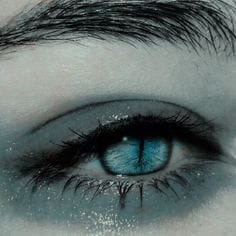
But I also want a life under water. I want to live amongst sea creatures. I want to dive through the waves with dolphins and lounge about with blue whales. I want to chase after swordfish and enchant men with my voice. I want to float with ease in the depths of the ocean. I want illuminating plankton and a vast world out in front of me. I want sea shanty’s and legends made in both warning and awe of what I can do with just my voice.
There are many lives I’d like to live.
But I was given this one for a reason.
11 notes
·
View notes
Photo



Process Blog
Research
What is ocean acidification?
Oceans absorb a substantial proportion of the CO2 emitted into the atmosphere by human activities
Kelp and eelgrass can prove effective in dramatically reducing the levels of dissolved CO2 in water
As we burn more fossil fuels and clear forests, our oceans absorb more and become more acidic
Ocean acidification is often expressed in terms of the pH of seawater. pH is a measure of acidity or alkalinity. A pH below 7 is considered acidic, and a pH greater than 7 is considered alkaline, or basic.
As oceans absorb more carbon dioxide, they become more acidic and corrosive
The water potentially becomes lethal to a large swath of creatures that play a huge role in aquatic ecosystems, the Northwest economy, and our dinner plates
The process also robs seawater of carbonate ions, a key building block for shells and skeletons and an ingredient so essential to ocean life that some call it “the soil of the marine world.”
The acidity of the oceans has increased by 26 % since about 1850, a rate of change roughly 10 times faster than any time in the last 55 million years
Impact of ocean acidification
Communities whose livelihoods depend on fishing are being affected, and more will be. Significant portions of our economy rely on the ocean's bounty in one way or another.
Ocean acidification threatens the survival of the multi-generational coastal businesses that employ hard-working Americans.
From 2006 to 2008, several oyster growers in the Pacific Northwest nearly declared bankruptcy because they lost more than 80% of their larvae—the baby oysters
In 2014, a Canadian shellfish farming company reported that they lost 10 million scallops and $10 million due to ocean acidification
Two important planetary ecosystems, coral reefs and polar regions, are on the front lines of the acidification crisis
Coral reefs critical to the protection of coastlines across tropical and subtropical parts of the world will disappear as the rate of erosion exceeds the rate at which corals can rebuild — with staggering repercussions for related ecosystems like mangrove and seagrass
In the north and south polar regions, marine plankton will be lost; some are already growing thinner and weaker shells. For example, pteropods are an important staple in the diet of salmon, mackerel, herring, cod and baleen whales
The ability of some fish, like clownfish, to detect predators is decreased in more acidic waters
Studies have shown that decreased pH levels also affect the ability of larval clownfish to locate suitable habitat
What can we do about it?
Reduce damaging emissions by approving policies that limit or put a price on carbon dioxide pollution
Use existing laws to curb pollutants that worsen the impacts of acidification
Invest in research and monitoring to determine how species will be affected, better manage fisheries, protect important habitat, and help seafood producers adapt
Try to reduce your energy use at home by recycling, turning off unused lights, walking or biking short distances instead of driving, using public transportation, and supporting clean energy, such as solar, wind, and geothermal power
creating meadows of seagrasses or kelp farms can help lower acidity and help bivalves build their shells because of all the CO2 they extract from the water
In order for kelp to be useful, however, it must be harvested, thereby removing the extracted carbon from the entire ecosystem
Citations
August 13, 2015 Perrin Ireland. “What You Need to Know About Ocean Acidification.” NRDC, 23 Oct. 2019, www.nrdc.org/stories/what-you-need-know-about-ocean-acidification?gclid=Cj0KCQjw38-DBhDpARIsADJ3kjlVNeRFbuTw90u_y1Xo8jRO_3h6B6w9kDY252fcUuGq0tQ_rWSYBLkaAl41EALw_wcB.
Brauner, Emily, et al. “Ocean Acidification.” Ocean Conservancy, 9 Nov. 2020, oceanconservancy.org/ocean-acidification/.
“Northwest Ocean Acidification.” Sightline Institute, 18 May 2016, www.sightline.org/research_item/northwest-ocean-acidification/.
“Ocean Acidification and Its Effects.” CoastAdapt, coastadapt.com.au/ocean-acidification-and-its-effects.
Ocean Acidification. www.biologicaldiversity.org/campaigns/endangered_oceans/index.html?gclid=Cj0KCQjw38-DBhDpARIsADJ3kjnxxygKpo5S2I7T6naJ7c0LiekqIURxB8wvgFtfYHlgSRnSgTUSvQoaAtafEALw_wcB.
The Ocean Portal Team Reviewed by Jennifer Bennett (NOAA). “Ocean Acidification.” Smithsonian Ocean, 20 June 2019, ocean.si.edu/ocean-life/invertebrates/ocean-acidification#segment_91.
Staff, Written by League. “Acidification and the Arctic Ocean.” Alaska Wilderness League, 12 Oct. 2020, www.alaskawild.org/blog/acidification-and-the-arctic-ocean/.
Proposal
I am advocating against Ocean Acidification which is the process of the ph level of the ocean rising because of all the extra carbon dioxide it absorbs due to air pollution from factories and other man made machines. My target audience includes big corporations that continue to pollute our atmosphere and oceans, as well as teenagers and adults who can be influenced to care for the environment and make a difference because this is our home. This topic is important because it not only impacts the ocean, but it also affects the economy. If shellfish such as lobsters, crabs, and oysters were to continue to die off, then seafood companies would go out of business which would result in higher unemployment rates. There are also communities that depend on fishing that are being impacted. I have three main categories that I will be discussing in my infographic 1) What is Ocean Acidification? 2) Impacts of Ocean Acidification 3) What can you do to help? Under each category, I will have boxes connected with a line to each category title containing the information for each category. For my design, I am planning on having two levels in my poster, the land and the ocean. On the land I am going to put factories producing smoke and having the title in the smoke. In the ocean, I am going to have my information along with some graphics like oysters, fish, kelp, coral, and other things. For the typography, I am going to use a more unique font for the title called Active Regular and more clean fonts for the subtitles(Berlin Sans FB), information (Calluna Sans), and facts (Bernhard Gothic URW) so that they are easier to read. I also plan to have my work cited to be in either the bottom left or right corner and have the text box be somewhat transparent so it won’t stick out as much.
1 note
·
View note
Text
June 1 2019 Paris

This faux tennis ball, made of flowers, was really as big as it appears! There were many people staying in the hotel who are attending the French Open at Roland Garros stadium, and perhaps the tournament organizers wanted to attract others with this form of publicity for the tennis tournament.
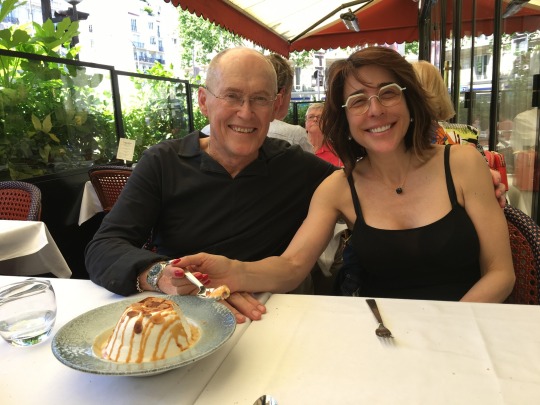
After working out this morning in the gym we went to lunch with Mike and Carolina at a very nice brasserie, where we dined al fresco, and ate a delicious lunch. Carolina and Michael ordered this scrumptious dessert and we all had a bite. Then we walked off our lunch over to the Georges Pompidou art museum, which has been one of our favorites in the city.

This is the view of the city from the terrace of the Pompidou. I love the photo I took of Michael and Carolina, in which they look like the quintessential Parisian couple.

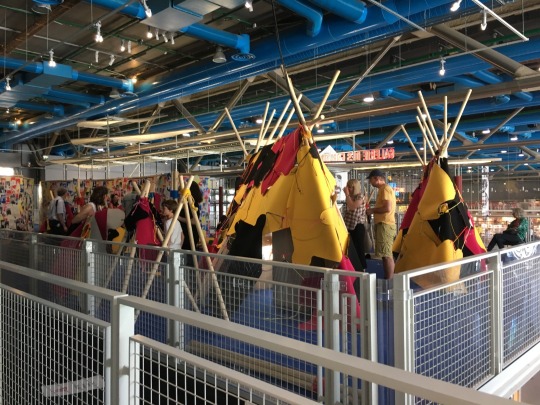
I did NOT expect to fine teepees (tipis) inside the museum, but there they were in the children’s section, looking much more Parisienne than American!
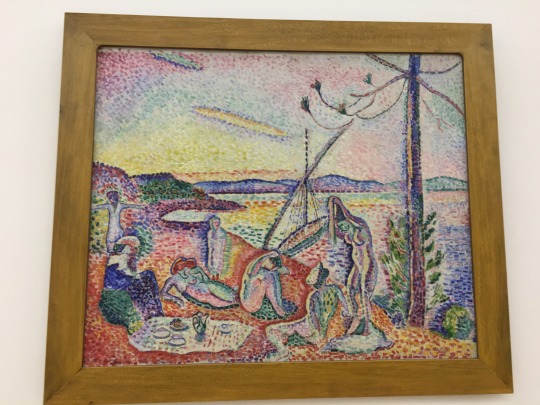
I love coming here and seeing works by my favorite painters, mostly Impressionists, as well as new masters each time we visit. Above is “Luxe, Calme et Volupte” which was painted in 1904 by Henri Matisse. It colorful, which is definitely Matisse’s style, but also a bit more surrealistic than most of his works. If it isn’t obvious that it is a nudist picnic on the banks of a beautiful lake, perhaps now you can see why it’s called “voluptuous”. According to Wikipedia:
“Henri Émile Benoît Matisse (31 December 1869 – 3 November 1954) was a French artist, known for both his use of color and his fluid and original draftsmanship. He was a draftsman, print-maker, and sculptor, but is known primarily as a painter. Matisse is commonly regarded, along with Pablo Picasso, as one of the artists who best helped to define the revolutionary developments in the visual arts throughout the opening decades of the twentieth century, responsible for significant developments in painting and sculpture.
The intense colorism of the works he painted between 1900 and 1905 brought him notoriety as one of the Fauves (wild beasts). Many of his finest works were created in the decade or so after 1906, when he developed a rigorous style that emphasized flattened forms and decorative pattern. In 1917, he relocated to a suburb of Nice on the French Riviera, and the more relaxed style of his work during the 1920s gained him critical acclaim as an upholder of the classical tradition in French painting. After 1930, he adopted a bolder simplification of form. When ill health in his final years prevented him from painting, he created an important body of work in the medium of cut paper collage.”

This is “La Reve”, or “The Dream”, also by Matisse, which he painted in 1935 and it’s clear he is very taken by the female form. Maybe she is dreaming of the picnic, which inspired him to paint the “Luxe” painting five years later!
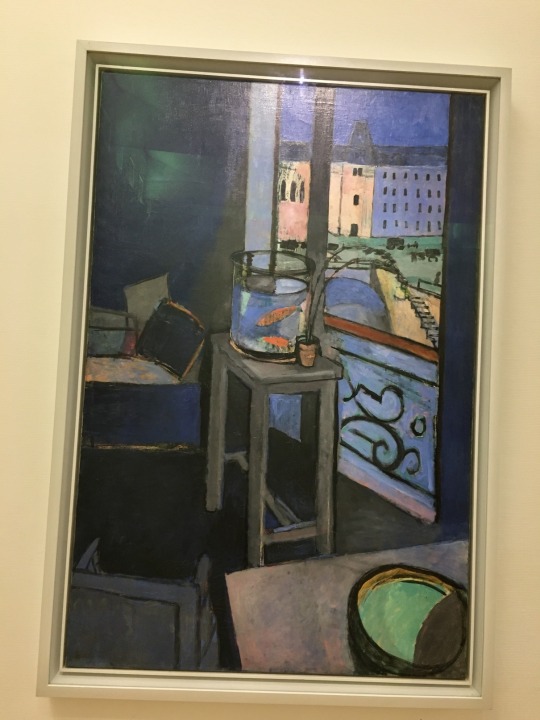
This is an early Matisse, painted in the spring of 1914, called “Interieur, bocal de poisson rouges” or “Interior, fish bowl with red fish”. It’s a bit less colorful and surrealistic, more impressionistic than his later works.
I find it interesting that Matisse first started to paint in 1889, after his mother brought him art supplies during a period of convalescence following an attack of appendicitis. He discovered "a kind of paradise" as he later described it, and decided to become an artist, deeply disappointing his father, who wanted him to become a lawyer. I wonder what might have happened to him if he had never had the appendicitis? We might have missed out on all the beautiful works of art he created when he found his true calling.
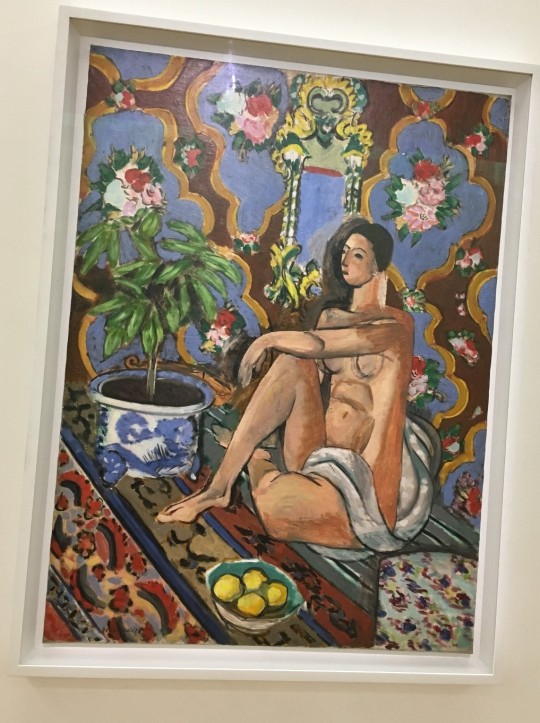
“Figure decoratif sur on fond ornemental” or “Decorative figure on an Oriental rug” , painted from 1925-1926, is one of my favorites. Again we see the richness of the colors, the natural theme with fruits and plants, and the female form, all very sensuous and alluring.

I would never have thought this was a Matisse until I read about his draftsman days. It’s called “La Mer” or “The Ocean” and now I can see sea creatures, plankton, and coral in it. It’s quite different than anything of his that I’ve ever seen.

This is “Improvisation” by Vassily Kandinsky, painted in 1909. I like the bold colors and the horse and rider remind me of a superhero, with a cape, although perhaps it’s a princess. That’s the thing about surrealism, things aren’t always what they seem.
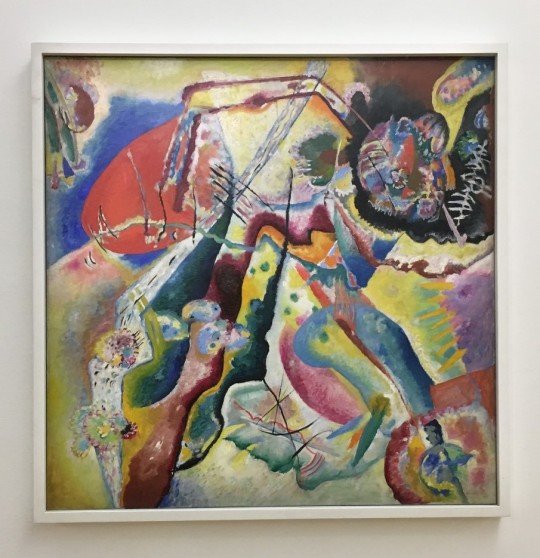
Here are two other Kandinskys and they are both a riot of color and so abstract I can’t see a single thing in it which looks like anything I recognize as “real”. But I like the way they flow and the way the shapes work together in a harmonious whole in both.

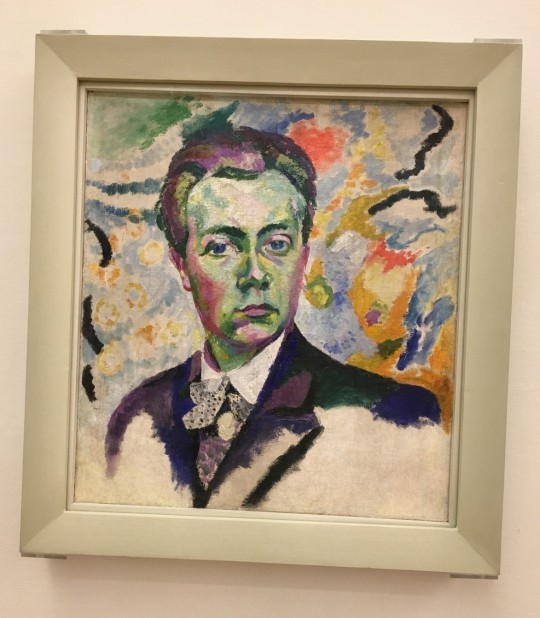
Robert and Sonia DeLaunay are a couple who are both famous painters. I saw them for the first time at the Pompidou when we were here in 2015 with friends from Boulder.
“Robert Delaunay (12 April 1885 – 25 October 1941) was a French artist who, with his wife Sonia Delaunay and others, co-founded the Orphism art movement, noted for its use of strong colours and geometric shapes. His later works were more abstract. His key influence related to bold use of colour and a clear love of experimentation with both depth and tone. “
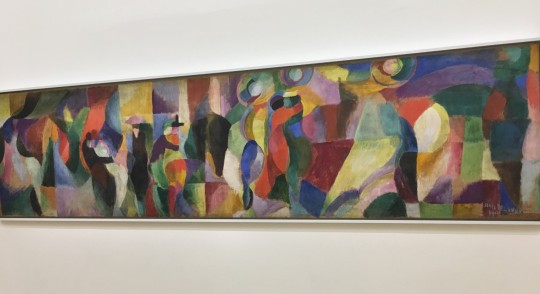
“Le Bal Bullier” by Sonia Delaunay roughly translates to “a crowded party”.

“La Jeune Italienne” meaning “the young Italian” by Sonia DeLaunay is much more subdued than most of her other works.
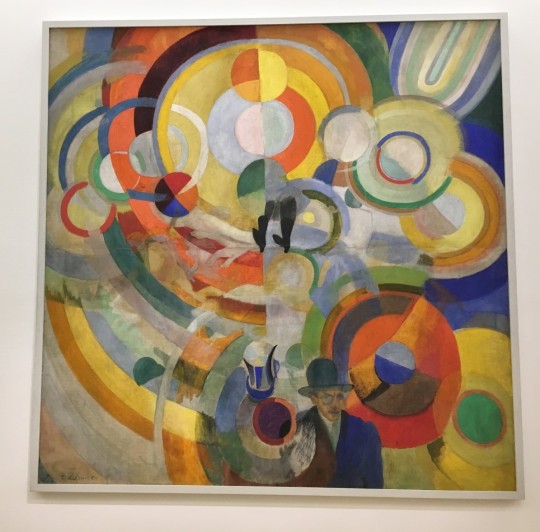
Robert DeLaunay’s “Manege de Cochon” makes me a bit dizzy with all the colors and swirls, but, no surprise, because manege means merry-go-round!


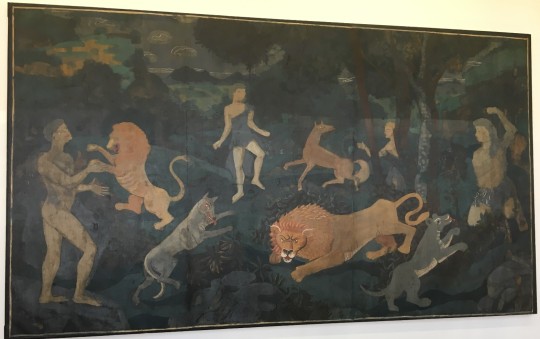
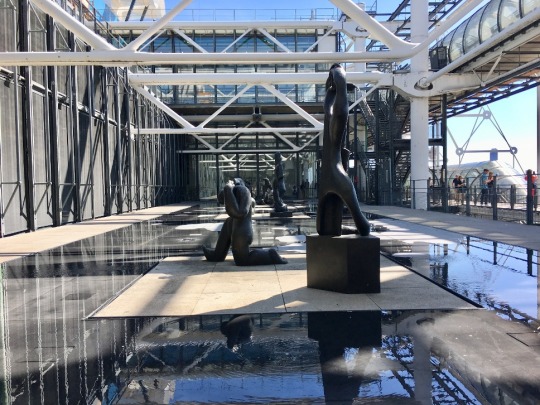
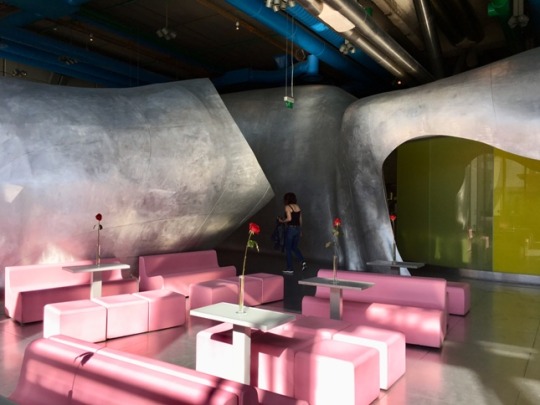
After visiting the museum for two hours we had tea in the colorful, ‘50s era tearoom. All the pink was a bit much but VERY French and stylish.
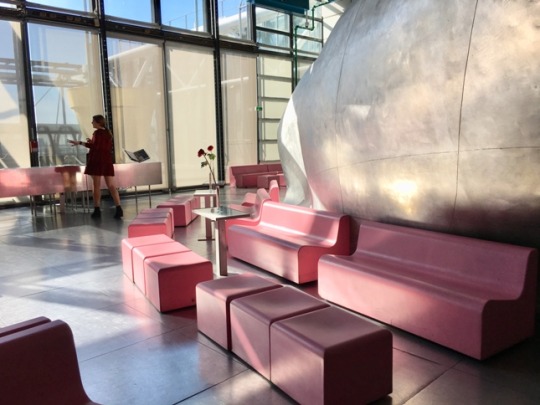

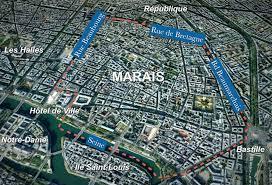

“Le Marais ("The Marsh") is a historic district in Paris, France. Long the aristocratic district of Paris, it hosts many outstanding buildings of historic and architectural importance. It spreads across parts of the 3rd and 4th arrondissements (neighborhoods) in Paris (on the Rive Droite, or Right Bank, of the Seine). Once shabby, the district has been rehabilitated and now sports trendy shopping and restaurants in streets such as Rue des Francs-Bourgeois and Rue des Rosiers....

During the late 18th century, the district was no longer the most fashionable district for the nobility, yet it still kept its reputation of being an aristocratic area. By that time, only minor nobles and a few more powerful nobles, such as the Prince de Soubise, lived there. The Place des Vosges remained a place for nobles to meet. The district fell into despair after the French Revolution, and was therefore abandoned by the nobility completely, and would remain so until the present day.

After the French Revolution, the district was no longer the aristocratic district it had been during the 17th and 18th centuries. Because of this, the district became a popular and active commercial area, hosting one of Paris' main Jewish communities.[citation needed] At the end of the 19th century and during the first half of the 20th,[ambiguous] the district around the rue des Rosiers, referred to as the "Pletzl", welcomed many Eastern European Jews (Ashkenazi) who reinforced the district's clothing specialization.[clarification needed][citation needed] During World War II the Jewish community was targeted by the Nazis who were occupying France.[clarification needed][citation needed] As of today the rue des Rosiers remains a major centre of the Paris Jewish community, which has made a comeback since the 1990s.”



This neighborhood of Le Marais was celebrating Gay Pride Week with a flourish! Carolina first noticed the fascinating pastries in the pastry shop in front of her and Bruce and, on closer inspection, I appreciated their laughter.
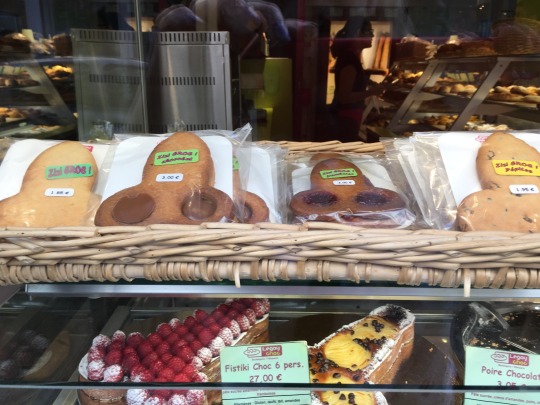
If you might have thought these pastries were rockets, look again!
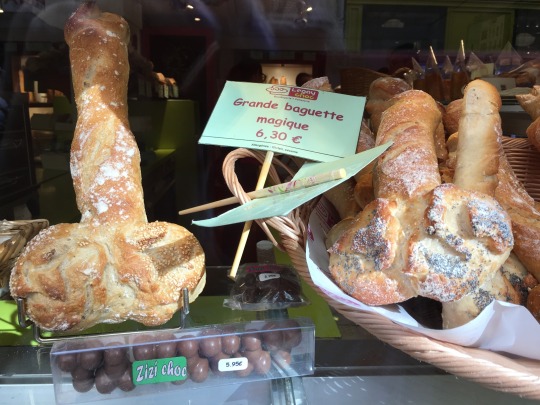
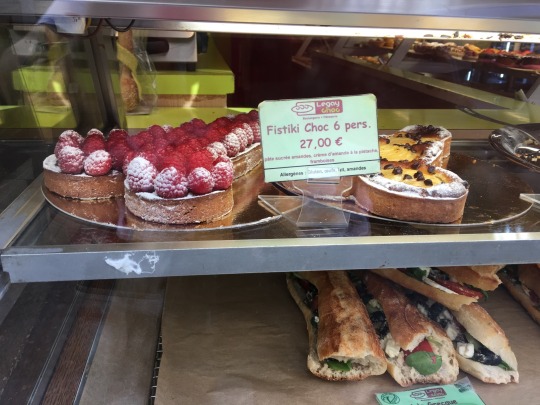
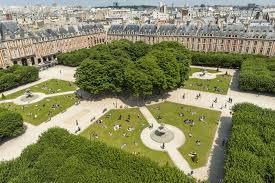

Our concierge recommended an excellent Italian restaurant, Mamo Italian, within walking distance, so we had dinner there and very impressed by the decor and the quality and variety of the dishes.




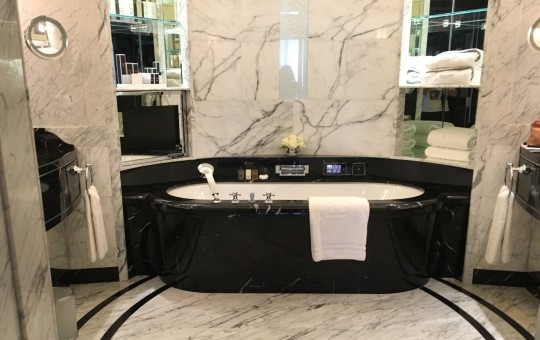
How nice to come back to the comfortable suite after a long day on the town and sink into the cozy sheets, dreaming of the adventures to come.
1 note
·
View note
Link
Eoin Finn and Chelsey Korus are both world-renowned yoga teachers with a passion for the planet. In this special—and crucial—conversation, they discuss how the philosophy of yoga requires that yogis be environmentally-minded, and why it matters to them.
Want in on their passion to change the world? It’s not too late to sign up for their Blissology EcoKarma Immersion at Wanderlust O’ahu! For more information, click here. For tickets to O’ahu, click here.
A line in the Isha Upanishad translates to: His friends were shocked to find that despite the beauty of the cage the poor bird was dying. It can be interpreted as a cautionary verse, reflecting on the averse impact humans can have on the natural world. Wisdom of ancient spiritual texts are often transcendent of time and culture, and certainly the metaphor of a dying bird resonates with the pains we are experiencing in this modern moment. The planet is changing because of the human influence.
With a rise in volatile weather patterns, changes in ecosystems, and dwindling landscapes that were once thriving, we can’t help but pose the question, what is a yogi to do? We turned to two outspoken natural world lovers, activists, and international yoga teachers, Chelsey Korus and Eoin Finn, to ask for their perspective on how we can individually and collectively support, protect, and revitalize the environment.

Eoin Finn teaching in the sunshine at Wanderlust O’ahu 2017. Photo by Melissa Gayle
How has your relationship with the environment informed your practice as well as your teaching?
Chelsey: My teaching and my practice revolves around wonder. The word is on my vision board and I see it as a gift that is given to us by the earth. Nature gives us a common language and it is told through the voice of wonder. The more I am connected to the wonder of nature, the more I am inspired, and the more authentic I can be. When I am in that place of wonder and awe, I am completely present and therefore can speak to what is currently happening in and around me. The earth gives me a gift every time I connect with her, and it is from that gift that I teach.
Eoin: I agree 100 percent with Chelsey. Wonder is one of the major purposes of being alive. We aren’t supposed to be on autopilot but work to open all of our senses.
I am old enough to look back on my life and reflect on my years here and what has been guiding me. I realize that a big question I am answering is what actually happens to us [on every level] when we get quiet in nature. What happens to our bodies, minds, cells? That is the constant question, since I was 12, that I have been trying to answer. It’s a question that brings forth wonder and awe, and it takes place in nature.
Why should we prioritize reconnecting with the environment? What are some ways we can develop a relationship with the natural world?
Chelsey: We’re in an age of uncertainty. We are searching everywhere for happiness and ease. Yet, all we need to do is look to nature to get the wisdom we need to live clearer lives. The tree knows how to thrive, and the bird has been around far longer than we have. We can look to nature to get closer to what we want, what we need, and what we need to do.
Yoga is a perfect practice to help us steep into the wisdom of the natural world. Yoga asks us to get quiet and wake up to the present moment. Find a daily sit spot. Go to the same place in nature and simply be a witness. Choose one time to be in nature and witness it. This is meditation: a witness to the now. We receive so much when we step into observation of everything the natural world has to show us and share with us.
Eoin: I’ve noticed as I travel and teach, is that there is a thrust to be in a yoga studio and be able to do certain poses. I think we’re taking a wrong turn with where yoga is going. We’re not emphasizing deep connection with nature, and in my perspective, nature is an essential part of the yogic path. Even if you are on the 30th floor of a crowded city, we must become aware in our hearts that no matter what we are connected to nature.
Every second breath we take comes from plankton in the ocean. The breath itself is a sacrament that connects us back to a harmonious relationship with the natural world. I would also say the source of real health is to be in connection with nature. Not to put your legs behind your head, but first and foremost, anchor into our innate bond with the natural world.
What would you say to someone who feels despair about the state of the environment as they witness what’s happening on and to our planet?
Chelsey: This is real. I cry everyday because I feel the Earth is hurting. But that’s a good thing. We want to choose to feel the connection to the environment. At the same time, when you’re out there in your world, the only thing you can do is be the hands and the feet of the change. Nothing else will give you the joy you will feel by cleaning up your immediate environment. Do one thing to support mother earth in a way you can. Pick up the trash you walk by in your community. It can be that simple.
Here’s the way I look at it. Love what you love enough to take care of it even when you’re upset.
Eoin: Side note: I am so stoked for what we’re going to do in Hawaii with Wanderlust! But the struggle is real. Just turn on the news to see the debate about whether climate change is real. It is easy to give up hope and crawl under a rock. However, what’s the purpose of my response? Do I want to be a part of the change?
Let’s look at the third chakra, which is where this issue resides. When we get imbalanced and feel anger or sadness at the state of the world, we can harness the energy of the third chakra and channel it into compassionate action.
What can we actually do to help the environment?
Eoin: I think it’s a question we can all ask ourselves. I discovered that I wanted to help the ocean, especially the coral that is rapidly disappearing, and it’s essential to our ecosystem. I decided to host include coral reef restoration into my Blissology retreats. It’s called the EcoKarma Project, and what I’ve discovered is that the feeling you have when you are in action and in community, is so much more satiating then when we’re simply talking about the issue.
Use what you’re feeling when you become connected to the environment as fuel for change. Ask, what can I impact as part of my yoga?
Chelsey: What’s so great is that when you decide to get involved, how to get involved is going to present itself because you’ve put the idea into your awareness. Keep your eyes and ears open for people and organizations doing work for the environment and either send them a message and ask how you can get involve or give them a shout out on your social media feed to spread some light to your community on what they are doing.
Eoin: In my opinion, the first step to saving the planet is the same step it takes to be a healthy conscious human being: falling in love with the natural world around us. Give yourself the gift of five minutes each day. Put away your smartphone and open up your heart-phone. Be with the beauty of nature and simply steep in it.
Watch the above video for Eoin’s meditation to put away the smartphone.
Eoin: What will happen is you will fall in love with it, and then you will become aware of what you can do to help. I think about the book The Little Prince, “If you want to build a ship don’t drum up people to collect wood or assign them tasks, teach them to fall in love with the vast and infinite sea.”
Chelsey: Also, we can only be in service of what we love. Growing up in Minnesota, I was scared of nature and the world around me, but I knew in my heart that there was deep healing to be had through a relationship with it. I began to treat the natural world like a relationship; I courted nature. I spent time with it, I got to know it in my own way. and overtime I fell in love with it. As Eoin said, start by falling in love with environment, and you’ll know what you need to do to support it.
Anything else you feel inspired to offer on this topic?
Eoin: For my urban yogis, if you can’t ind any nature to fall in love with, look up. The clouds and stars are always there. Nature is everywhere. Look up, pause, and be with the infinity of the sky. Let it light up your heart. Let’s become more obsessed with the stars in the sky than those in Hollywood.
In summary, we are invited to open our eyes to the world around us. Steep in the wonder of what is right here. Fall in the love with this playground of a planet, and do what we can when we can to honor and protect her. As Chelsey so eloquently put it, “we must simply love what we love enough to show up and do our part.” With all of our individual efforts added together, the hope is that the beautiful cage will become much less important than the thriving of the miraculous bird inside of it.
—

Erin Ward is a freelance writer, yoga teacher, and instructor at Wanderlust Hollywood.
1
The post Before It’s Too Late: A Crucial Conversation on Yoga + the Environment appeared first on Wanderlust.
0 notes
Text
15.01.19
We woke up in the much nicer Wild Bungalows, packed our bags and headed for breakfast. Typically on our last day we found an incredibly good Italian restaurant, Eno Cafe, that set us up to make the journey to a different beach.
We found a boat willing to take us to Coconut Beach on the northern tip of the island. The boat chugged along the coastline as we soaked in the view.
When we arrived we were immediately pleased with our choice. The water was absolutely clear and you could see large schools of fishes swimming below the jetty. The beach was small and quiet with just three or four hotels and bungalow complexes. We walked the length of the beach looking for accommodation but unfortunately only expensive places were left. As we walked out of the last place the owner ran out after us and offered to let us sleep on his campsite for free in two of his hammocks. We took him up on his kind offer and he showed us a small room to lock away our luggage.
We went and lay on the beach for the rest of the day enjoying the clear warm water.
After a full day on the beach we went to the camp and realised the weather had forecast rain tonight but after a long debate we decided to brave it. We went for dinner at the restaurant upstairs where we met a really strange woman who stared at Jodie and then approached us and spoke absolute nonsense. She introduced herself as a crazy person and this later turned out to be true.
Having set up our hammocks and mosquito nets we went on to a boat tour we'd booked to see the plankton that glow underwater in the dark. We drove out into the dark ocean and jumped into the water with our goggles. When we ducked underwater and moved our hands we could see the little organisms light up like little blue flashes in the dark sea. Unfortunately the full moon tonight meant it wasn't quite as vibrant as advertised as you need to be in complete darkness, but it was still cool to see what little we did.

Fortunately we found the staff of a hotel at the other end of the beach who let us sleep on the floor of their restaurant on cushions from their deckchairs and life jackets as pillows. We had a poor nights sleep but it felt better than where we were. We later found out we were not the only ones that escaped the madness.

An hour later we were back on land and after a chill by the fire we crawled into our hammocks ready to settle in.

The hammocks were surprisingly really comfy and we slept well for an hour or two until the crazy woman we had met earlier came down by the fire and went full on physcho. She picked up burning logs and threw them near us, screaming like a person possessed and pretending to blow up the tents with her mind. She may have been on something and she was becoming scary and violent and we weren't keen on sticking around to see what she was capable of.
Lying motionless and exposed in our little hammocks she eventually walked up the hill to terrorise some of the bungalows so I got up and told Jodie we needed to go. It was 1.30am and we left and wandered the dark beach with our sleeping bags hoping to find a safe place to duck away. We could hear her blood curdling screams go on for hours.

0 notes
Text
We humans are strange. I don’t know of any other living being on earth that does so deals horribly with nature and the environment like humans. He not only exploits our earth massively, he also poisons it with his filth. He simply throws all of his produced garbage into the environment without ever having thought about the damage he is doing with it. According to the motto: out of sight out of mind. We speak of “cycles of nature” etc., but we do not want it to be true that this bad deed of us humans returns fully and directly to ourselves and hits us hard. Because this is the cycle of nature!
Tourist in the middle of the garbage ©Foto: Gérard Koch, 2017
Hawaii is a dreamlike paradise in the Pacific Ocean. Already in 1967, after barely 8 years under the United States government, Hawaii reached the first million tourists, especially since around 7 million visitors from all over the world travel there every year. But Hawaii has a major environmental problem due to these tourists and its geographical location, which one is happy to suppress. My wife and I were able to experience this ourselves in 2017 in Kahului, Maui on the beach. The whole beach was overflowing with plastic, microplastics, old fishing nets and other garbage. Warning signs for swimming were also appropriate. In short, we decided to collect the rubbish on this small stretch of beach.
Collecting the waste – ©Foto: Gérard Koch, Dez.2017
In order to perhaps document the understanding with a few numbers, I have given just two examples:
The smoker habitually throws the rest of the cigarette onto the street, into the river or wherever after his satisfaction. The world is the biggest ashtray. Although cigarette consumption is declining in Europe, 5.6 trillion cigarettes are smoked worldwide every year (2011 figure), 4.5 trillion of them are being carelessly thrown away. In terms of weight, this means that 1 million cigarettes weigh exactly 1 ton. This is about 5 million tons of cigarette waste in nature every year. Human mortality from smoking every year is around 6 million people. One cigarette contains 4,800 chemicals, including 250 poisons (as of April 3, 2018, SZ.de), 50 of which are carcinogenic. The other chemicals are still under investigation. The cigarette filter is made robust by chemical processes during manufacture and takes 10 to 15 years to dismantle. If a cigarette butt comes into contact with water, it contaminates 200 liters of it and, through chemical reactions, generates around 7,000 poisons in the water, which does not benefit wildlife and nature. In the water, the filter decomposes into its microplastics, which is taken up by the plankton (microorganisms in the water), which in turn is the basic food of the fish, which we, the fish, in turn consume. A great cycle, I only wish you a good appetite!
Another example is plastic:
The oceans and the sea are used by our society, industry and government as cheap dumps. Studies estimate that 675 tons of garbage are disposed of directly into the sea every hour, half of which is plastic. The dismantling of the plastic, one is amazed, takes about 500 years. Almost 1.5 million tons of plastic were produced each year in the 1950s, today it is almost 400 million tons. Let’s take the 128-year-old company Coca-Cola, which produces over 100 billion plastic bottles a year. This is about 3,400 bottles per second! According to the Greenpeace studio, 60% of these are single-use bottles that can be found in any way in nature and the ocean.
Researched and registered by the United Nations Environment Program (UNEP), 4.8 to 12.7 million tons of plastic end up in the sea every year. The ocean currents then create the giant new plastic continents in the middle of the oceans, which cost around 135,000 marine mammals and one million seabirds each year. The best known new continent is the “Great Pacific Garbage Patch” in the North Pacific between Hawaii and California.
youtube
We humans urgently need to be more careful, gentle and close to nature with our environment and nature, because we have only one earth, where we all live together. We have to do something as soon as possible and clean up and detoxify our landfill. If we can all throw something on the floor, we can all pick something up from the floor, right? Let’s do this as our new sport.
Born in Mexico, Fernando, who has lived in Hawaii for 20 years, took this to heart. When he walked along the Ala Wai boat harbor and saw the splendid, colorful fish swimming in the immense pollution, he took the initiative and began cleaning the harbor basin from debris. Without an order from the city or the community, he goes to the port in Honolulu once or twice a week after his 100% job to clear the debris. Instead of being grateful for his free, hard work, the government put stones in his way and tried to prevent him from cleaning the water. Regardless of this, Fernando goes his way and not only cleans this port in Honolulu, but extends it to the island and cleans nature with great diligence. We should all be grateful to him and support him in this. One possibility would be to help him or to start freeing the environment from civilization ballast in the area, on his own doorstep. Fernando is a great role model for me, a hero. He shows us what to do and opens our eyes. My request to you, dear reader, please become active like Fernando. Support him wherever you can, be it financially or just that his social media community is growing, which you can find here: Instargram: @greenmanhawaii facebook: Green Man Hawaii
youtube
Mahalo nui to Hawaii Volcanic
youtube
My contribution to him is that as soon as I can fly back to Hawaii, I will keep my promise to Fernando and help him fish the garbage out of the water for a day or two. I will also suggest him as a real hero at the organization at Trash Hero World, so that he may also get support from there.
A huge thank you and Mahalo nui to Fernando, as well as an appreciation for everything he does. Fernando, is a hero!
Photoalbum
Motor of a car – Big Island – 2017 ©Foto Gérard Koch
the rest of a car – Big Island – 2017 ©Foto Gérard Koch
Fishernet – Maui – 2017 ©Foto Gérard Koch
Everywhere is tresh – Maui- 2017 ©Foto Gérard Koch
Harbor of Kahului – 2017 ©Foto Gérard Koch
Warning for swimming – Maui – 2017 ©Foto Gérard Koch
Tourist in the mittle of waste – Maui – 2017 ©Foto Gérard Koch
It say byself… , Maui – 2017 ©Foto Gérard Koch
Cleaning up by Kahului, Maui – 2017 ©Foto Gérard Koch
Everywhere the trash… Maui – 2017 ©Foto Gérard Koch
Almost the End of Cleaning Maui – 2017 ©Foto Gérard Koch
Good feeling after cleaning,Maui – 2017 ©Foto Gérard Koch
Ala Wai Harbor Honolulu witch cleans Fernando, Oahu – 2018 ©Foto Gérard Koch
Link:
Bericht über Coca-Cola Die Welt-Zeitschrift über Coca-Cola Watson Coca-Cola Schweiz Coca-Cola Global Citizen über den Abfall in Hawaii Reset United Nations Environment Programme UNEP Pollution in Honolulu Oceanservice – Plankton Australien Museum – Plankton
Fernando, a tireless hero We humans are strange. I don't know of any other living being on earth that does so…
0 notes
Text
Cambodia! What a wonderful country to visit, I’m so grateful to have spent so much time here.
Visas are an easy on arrival, $30USD for 30 days or $35 for a “business” visa, which means you can then extend, while in the country. For up to 12 months, which is what I did, so it become a base country while I was in Asia for a big stint. Also maybe because I just fell in love with the country and truth be told, found it hard to leave! One huge thing you’ll notice with Cambodia, is the spirit of the country. They have an incredibly brutal history, with only recently recovering from the Khmer Rouge. Yet the overwhelming warmth and hospitality you will receive is beautiful.
So here’s the top 5….. I’ve done these in order of North to South.
1. Siem Reap
If you’re coming across from Thailand, after Poi Pet you’ll end up getting the bus to Siem Reap. However as easy as this border crossing is, make sure you have some USD and extra passport photos, because you won’t be getting them there. There’s nothing in Poi Pet so don’t worry if you go straight to Siem Reap, you’ve missed nothing!
And what’s the most famous thing you can do in Cambodia…. Angkor Wat of course! Don’t miss it, you’d be silly if you did! Now I’ve seen some temples and this one, well few, are incredible!
The picture below is the sunrise, which admittedly you start at 4am but worth it!
Where to start with this, there’s a few different ways you can do it. It’s of course out of the city but not to far out that you couldn’t bike to it. I’ve been a few times, as I had horrific food poisoning the first time so couldn’t get through it all. That first time, I was unsure of everything so naturally got a Tuk Tuk to take me up, they’ll charge about $25-$35 USD for the day, but there with you all day, they’ll take you from temple to temple and honestly in the blazing heat is a nice little break! Also being on my own, it’s nice to have a local to talk to, who will usually tell you heaps about not only Siem Reap but also Cambodia!
So the other stinger for this guy is the price…. It’s a whopping $37 USD for 1 day – $62 USD for 3 days and finally $72 for 7 days. Expensive right! Anyway it’s the most expensive thing you’ll do in Cambodia, so suck it up and pay it! If you’re short on time then naturally slam around it in 1 day, which is doable, however if you’ve got the time, I would do the 3 days, take the time to do the sunrise one morning and just chill there, it’s a wonderful place to just be. I took my yoga mat and found some lovely spots.
So outside of Angkok Wat, what else is there to do? There’s a lot of places to eat, drink and enjoy. Heaps of yoga retreats and a lovely little town to walk around. Make sure you check out, ‘Dine In The Dark’ exactly what it says on the tin! It’s a restaurant that supports the blind, with guided blind workers, you’ll eat your entire dinner in the dark! Defiantly one of my favourite places I’ve ever eaten! It’s amazing what you can taste when you can’t see it!
Finally though do not miss the Siem Reap Circus. No animal just a beautiful story told through dance and acrobatics!
Sadly there’s a Killing Fields here too. Which is something you have to learn about, to understand the brutal backbone to this country.
2. Phnom Penh
In my opinion this city is underrated! Yes it is mental and maybe a little rough around the edges, but it’s filled with weird and wonderful adventures!
Most people I’ve ever spoken to about PP, has always just bounced through for the day and then moved on, down south, which isn’t a bad idea as the south is stunning, but give it at least 48 hours here!
So where do you start in Phnom Penh? You’ll find accommodation from as little as $2USD for a dorm bed! Cheap, delicious food, night markets, the big I mean HUGE central market, museums and temples galore! Speaking of which get yourself a Tuk Tuk out to Choeung Ek, the Killing Fields. Here you’ll pay a small fee to go around and listen to, on headphones accounts and all the information you need to know about what happened. Again some people avoid this, but please don’t, it’s the best way to understand everything that has happened. There’s a lot of museums and places to go in PP with regards to the Killing Fields. You can also check out Tuol Sleng Genocide Museum commonly known as S21. Unless you’re not really that emotional, don’t make the mistake I made and do them both in one day!!
Take a day or evening boat ride down the river and admire PP in all of her glory!
Other than that, just enjoy the madness of this city, because life down south is a very, very different vibe!
3. Sihanoukville – Otres Beach
Want a wild night out?? This is the place!! Sihanoukville that is. Otres is a completely different vibe! The reason I’ve put them together though is because I wouldn’t spend so much time in Sihanoukville but also wouldn’t miss it. Plus it’s about 7ks from Otres, so you’ll end up getting a bus into Sihanoukville before getting a Tuk Tuk over to Otres as it’s the next beaches down.
The picture above sums up the feel of Otres. Sadly it does have it’s rubbish parts and it’s devastating to see the actual rubbish on the beach, however there’s still parts that are lush. I find this a problem in a lot of Asia, so if you can do your bit, please do! There’s always volunteer groups you can join, even just for the day to pick up some crap! Right preaching over…. What more to know about Otres! There’s Otres 1, Otres 2 and Otres Village. Otres 2 is my least favourite due it being a little more up market, with some fancy places to stay etc… and then theres the other two which are completely different. The village is tiny, with places to stay on the river, the best donut shop I’ve ever found and a vibe that won’t let you leave your hammock! Ha how could I forget…. Kafufal the best free party, you’ll hit in Asia! This is renowned, with monopoly money you exchange for real dollars for the bar, great music, places to chill oh and a huge ferris wheel, which admittedly doesn’t look or feel so safe but great fun when you’re off your tits! Party all night and feel sorry for yourself in a hammock the next day!
So if you don’t stay in the village, you’ll end up in Otres 1. There’s heaps of places to stay, eat and drink. It’s just one dusty road, covered in palm tress and Tuk Tuks… My paradise!
4. Koh Rong and Koh Rong Samloem
Ok, Ok so imagine you’ve been at Otres, it’s paradise, you’re coming down, you’ve been glued to your hammock and eaten some of the nicest food ever! Just when you think paradise couldn’t get any better… It does! Head back over to Sihanoukville and jump on the boat over to the islands. This boat ride is super busy and well quite frankly bloody hectic. There’s not really much if any structure to it, which is fine but just brace yourself, as in peak season it’s pretty busy! Easy to go buy a ticket anywhere in the area, so if you want you can most likely buy one from the hostel you’re staying at, however much the same and if not maybe sometimes a little cheaper if you just go there and buy it yourself.
Admittedly I have been to Koh Rong, but I’ve spent the majority of my time on Samloem however, these islands, despite being sister islands, couldn’t get anymore different! Koh Rong being the big sister, is a party island, with a buzzing vibe and an array of places to spend your days and evenings. While Samloem establishments you could count on your fingers and toes! Both islands are run on gennies and Samloem power is cut off at 12pm and turned back on around 7am in the morning. So charge your shit!
But the cherry on the cake for these beautiful slices of paradise, is the bioluminescence plankton that surrounds them! Step out into the ocean at night and watch your feet glow! The darker the better so the less moon the better the experience! I’ve seen it heaps of times now, with going back to these beauties and it still gets me every time.
Be prepared to do nothing on these islands! Total time to chill! You can go on the little walk to the light house on Samloem and at least big Koh Rong offers a few more things to do, if Samloem is to sleepy.
Either way kick back and enjoy the pure, tranquil beauty of these islands.
5. Kampot
Kampot is wonderful! Set amongst the Preaek Tuek Chhu River, in southern Cambodia, this place is a slice of pure bliss!
Kampot itself as a small city, is a pleasant and easy place to get about. With everything you need, night markets, good coffee and plenty of places to choose from when it comes to food. However the best accommodation is a couple of Ks out of the city, on the river! Again super easy to get Tuk Tuks or even walk it. There’s heaps to choose from and there all pretty in a line with each other, so if you can be arsed then checking them all out wouldn’t be a problem. I love staying near water and even better this river is beaut to swim in!
But there’s more to this beautiful part of Cambodia, Bokor National Park! This must not be missed!! Get a scooter and drive the 37 or so Ks to the mountain! I’ve been here about 3 times because its wonderful! The first thing you need to see is the old French colonial town, where you’ll find the huge old hotel, commonly known as the “Old Casino” you can wonder around the many, many rooms and on clear days, you’ll see views for days!
But wait there’s more, take the roads down to the water falls and if you want to splash out there is a hotel you can stay at, I’ve not stayed so I can’t comment, however I’ve not heard bad things about it either. Best tip though, take a jumper, as it’s a welcome chill from the humidity of the city.
Bonus place! Kep if you have the scooter and want a day trip out ride the 30Ks there! It’s a lush little sea side town, renowned for it’s wonderful fresh sea food. Kep is an amazing place to get lost for a few days also. Take a little jungle hike while you’re there.
I can’t get enough of Cambodia and if you’ve got time then really get your teeth stuck into this one and embrace it! This country will teach you heaps about yourself and will leave you wanting more!
5 Top Spots In Cambodia! Cambodia! What a wonderful country to visit, I'm so grateful to have spent so much time here.
0 notes
Text
The not needed synthetic in you.

The strange part is that the chaos that exists is just for your pain, the madness within you the passion for you needs to be preserved for your consumer gain. The consumer in you is being served to the profitable you but at a loss of you. IF there is a need it needs to be addressed, they who address are the ones addressing because it is implied that they serve you for a profit from you, and at a cost at you. A desensitising targeting channel if based on the fundamentals of effective, efficient solutions to a human need, it will not only be useful but in fact, will be welcomed with open arms. The yard farm known as humanity not only serves like an ecosystem where earthlings live by and walk but also serves as an open field for an experiment on masses to serve a profit-oriented objective as well as to establish another system to serve the outcome of the previous system. An aspirin is needed when a headache is beyond control. A fire brigade is needed when the fire is beyond control. Wireless is needed when wires are beyond control. Hospitals are needed when sicks are beyond control. Sicks are needed when pharmaceutical industries are beyond control. AND likewise, synthetic based plastic products are needed when the human urge for immediate solution solving plastic is beyond control. Be it cup-noodles, be it a bottle of water, a soda bottle, or be it any daily product, it is most likely packaged in plastic or some by-product of plastic because nothing beats a quick, convenient, easy to open and use BUT non-bio degradable solution. Right? This discovery of plastic has changed, revolutionised and exploded and exploited within the cross-hair of corporate consumerism and profitisms (word carved by team chaospresss). Sadly the plastic which has become the second name to serve the human convenience after the never-ending human greed is a major contributor to the encroaching litter made by humans AND India also ranks amongst the one of the top waste-generating countries and littering is a major issue, especially in the form of single-use plastics, like soda bottles, drinking straws and potato chip bags throughout the country, and sadly not much is being done regarding the same. Research commissioned by media outlet Orb revealed alarming data about plastic pollution in tap water, with 83 percent of samples tested worldwide coming back as contaminated. In the U.S., 94 percent of tap water samples were found to contain plastic. Orb found, for example, 16 fibers in tap water taken at the visitor’s center in the U.S. Capitol in Washington, D.C., along with fibers in samples taken from Trump Tower in New York. Plastic fibers were also found in water taken from Indonesia, India, Ecuador, Uganda, England, and Lebanon. The plastic/ synthetic is non-bio degradable and it also has the tendency to break down into multiple small complex pieces of micro-plastic and has found its way deep into the ocean far beyond the human reach and has also contaminated the food cycle of the marine life, its long been known that fishes are eating plastic debris, but a disturbing study revealed, this isn’t occurring by happenstance. Instead, fish may be actively seeking out plastic particles in the ocean to eat, mistaking them for food because of their odor. When microplastics exist in the ocean, they form a biological covering made of algae and other materials that smell like the food the fish would normally eat hence entering into their body and causing loss to marine life at an extent which is yet to be ascertained. The Orb report even reported that plastic particles less than 50 nanometers long have been shown to collect in plankton, potentially (food on which whales thrive) blocking their gastrointestinal tract, as well as accumulating in the many creatures that depend on plankton as a food source. It’s yet another route of plastics exposures to humans, because if the fish are eating plastic, so, too, are the creatures that end up eating the fish. If plastic fibers are in our water, experts say they’re surely in our food as well be its baby formula, pasta, soups, and sauces, whether from the kitchen or the grocery. Plastic fibers may leave your pizza crust, and a forthcoming study says it’s likely in the beer you’ll drink to chase the pepperoni down. It gets worse. Sadly Plastic is all but indestructible, meaning plastic waste doesn’t biodegrade; rather, it only breaks down into smaller pieces of itself, even down to particles in nanometer scale — one-one thousandth of a one-one thousandth of a millimeter. Studies show particles of that size can migrate through the intestinal wall and travel to the lymph nodes and other bodily organs. Human inventions are a product of a necessity being the mother of its creation but the human need for an immediate solution has made the invention into a daily way of convenient lifestyle by the corporate consumer based convenience, without firstly having ascertained how the end result would be if used so extensively. Every packaging of almost every food product has become plastic, every bottle of water, soda, daily cosmetics are plastic. We breathe plastic we live plastic, it has, in fact, found its way even till the human face in the name of plastic surgery. What are we doing, where are we heading because the end seems nowhere near and neither does any possible solution to the havoc we have created just for the immediate needs to be solved based on human convenience arising from human greed. Lastly remember folks everything human, I mean everything ends up in the ocean! The maddening chaos seems close!
For more, you can read the following articles and the endnotes of myriad reports.
https://articles.mercola.com/sites/articles/archive/2017/09/19/our-bodies-becoming-plastic.aspx
#recycle#plastic#plasticwaste#synthetic#syntheticwaste#microbeeds#micrfon#ocean#waste#consumer#consumerism#pollution#waterpollution#chaos#polluted#plasticpollution#pollutedearth#marinelife#environment#cosmetic#profits#lifestyle#plasticsurgery#garbage#humanneeds#human waste#biologicalwaste#drywaste#wetwaste#biodegradable
0 notes
Text
SHOW NOTES Episode 17: Axolotl vs. Sea Apple
It's Episode 17 and this week we're looking at the coolest pets. Both animals this week are aquatic, have the ability to regenerate and are difficult (but worth the difficulty) to keep well.
Introduction
Theme: pets
Thanks to our wonderful patrons: Drunken Bear, Lauren “The Queen” G., Sophie “The Killin’” McMillan and Lady Georgia
News: cannibal croc
Adam’s Animal: Axolotl (9:55)
Classification Phylum: Chordata Class: Amphibia Order: Urodela Family: Ambystomatidae Genus: Ambystoma Species: A. mexicanum
The Axolotl is also commonly known as the Mexican walking fish. Despite this name they are not fish and despite their appearance, they are not reptiles; but are actually amphibians.
Description
As pets, the axolotl comes in many different colours including black, brown, white, golden and even pied.
In the wild they are usually light to dark brown with spots covering their bodies.
Generally, maximum length is 23-25cm however there have been some rare specimens recorded between 30 and 43cm.
They can take up to 2 years to reach their full size.
Wide head, lidless eyes
Underdeveloped limbs, long, thin digits
Males have swollen cloacae, females have wider bodies full of eggs
Three pairs of external gill stalks behind their heads, lined with filaments to increase surface area. Underneath external gills are four gill slits with gill rakers.
Three-chambered amphibian heart (unlike the mammalian four-chambered heart)
Poikilothermic (its body temperature is dependent upon its surroundings)

Photo of Ambystoma mexicanum (axolotl) at the Steinhart Aquarium in San Francisco. Credit: Stan Shebs (CC BY-SA 3.0)

Some rights reserved
Breeding Axolotls reach breeding size when they are at least 18cm in length; this can take anywhere from 5 months to 2 years. Breeding will generally occur at least once before the peak of winter and once in the spring. However they can breed throughout the year in optimal conditions or if they are subjected to changes in their environment. For example, decreasing the light over several weeks and then slowly increasing it will trigger breeding, as will dropping the temperature over a period of time. This is likely because these conditions mimic winter when the days are shorter and it gets colder.
Male axolotls go through a cycle where, although sexually mature, they may not have sperm available for mating. In the wild this seems to be determined to some extent by the seasons. However, in captivity it's less regular and may occur at any time of the year. It usually takes the male about 2-3 months to produce sperm and perhaps a further 2 months for the sperm to move into the vas deferens so that it is available for mating. This could mean that the overlap between having and not having sperm available could be a few weeks to a few months.
Diet The Axolotl is carnivorous, living on a diet of worms, insects, small fish, and just about anything else that can fit inside their mouth and swallow whole, including other salamanders. Its teeth are pedicalate (i.e. they're small stumps, like cones which isn’t typical of other carnivores that usually have well-developed, differentiated teeth) and are used to grip their food, manoeuvring it into position before swallowing it whole.
Life cycle They are salamanders and, like all amphibians, they have several different stages in their life cycle. In the case of most salamander species, the cycle starts in the water and they are fully aquatic to begin with. They start as eggs, and then the egg hatches into a larva form with gill buds like a frog tadpole. After this, it starts growing into larva with developing gills, forelimbs and the start of hind limbs. The next stage is the larva with fully formed limbs and gills, followed by a terrestrial or land living adult stage with lungs. However, axolotls differ to most other salamanders in that it retains its third larval form into adulthood rather than metamorphosing into the terrestrial salamander. This adaptation is known as neoteny; essentially becoming sexually mature in a larval state. This is often viewed as a backward step in evolution because it prevents the axolotl from living on land, and as a result, it can't colonise new habitats. However, it has led to the axolotl being quite successful in its native habitat, at least until the arrival of humans.
Although they retain larval morphology, they do develop rudimentary lungs, and axolotls can be seen to occasionally rise to the surface, take a quick gulp of air to fill these lungs, and then quickly descend to the bottom once more. It’s believed that the lungs develop shortly after the rear legs reach their full length.
Even though axolotls don’t progress to the last stage of metamorphosis they actually have the ability to, and there have been several cases where they have. In order to complete the metamorphosis they need to be injected with thyroid hormones to trigger changes in the body and kick start the change. But reports have claimed that the axolotl doesn’t tend to live a long and happy life after they have gone through this. It can happen naturally but is rare.
Conservation Axolotls are found in Mexico; exclusively in the lake complex of Xochimilco near Mexico City. Natural threats include predatory birds such as herons and larger species of fish. However, due to the growing city and expansion of human development, much of the axolotl wild habitat is in direct threat of being destroyed. They are listed as critically endangered by the IUCN and on CITES they are classed as extinct in the wild. Furthermore, axolotls are accustomed to being a top predator in their habitat and have begun to suffer from the introduction of large predatory fish like carp and tilapia into their lake habitat.
Populations are directly threatened due to the demands of the nearby Mexico City which has led to the draining and contamination of much of the waters of the Xochimilco Lake complex. They are also popular in the aquarium trade, and roasted axolotl is considered a delicacy in Mexico, further shrinking their numbers. It is believed that there are actually more axolotls as pets in Australia then there are in their natural habitat.
Regeneration Axolotls have an amazing regenerative ability; a young axolotl that loses a foot to a sibling or in a fight will usually grow it back over a period of a few weeks. This regeneration occurs via the formation of a "bud" at the end of the damaged appendage, followed by growth of the new foot. Entire limbs can be regenerated and even portions of the brain and spine. They have been used a lot in scientific studies and are thought to be one of the most studied salamanders in the world. They have been known to regenerate structures like limbs, jaws, tail, spinal cord and skin without scarring and they are even able to regenerate internal organs.
Here is a little snippet I read which was interesting and when you think about it kind of cruel for the axolotl:
You can cut the spinal cord, crush it, remove a segment, and it will regenerate. You can cut the limbs at any level—the wrist, the elbow, the upper arm—and it will regenerate, and it’s perfect. There is nothing missing, there’s no scarring on the skin at the site of amputation, every tissue is replaced. They can regenerate the same limb 50, 60, 100 times. And every time: perfect.
In my opinion though, just because it can regenerate it doesn’t mean it can’t feel pain so that would have sucked.
References All websites accessed 20th August.
http://ipfactly.com/14-fun-axolotl-facts/
http://mentalfloss.com/article/63130/11-awesome-axolotl-facts
https://en.wikipedia.org/wiki/Axolotl
http://www.nationalgeographic.com/animals/amphibians/a/axolotl/
http://www.softschools.com/facts/animals/axolotl_facts/256/
www.axolotl.org
www.caudata.org
Kirsten’s Animal: Sea Apple (30:00)
Classification
Phylum: Echinodermata – entirely marine, 5-way (pentamorous) symmetry (adults), calcareous endoskeleton (ossicles), water vascular system with mutable dermis and connective tissue. Largest phylum without fresh or terrestrial forms.
Class: Holothuroidea – sea cucumbers, worm-like and usually soft bodied
Order: Dendrochirotida – branched tentacles, suspension feeders
Family: Cucumariidae – small to med sea cucumbers. Ten branching tentacles (lowest two often smaller)
Genus: Pseudocolochirus
Species: (4 listed on EOI) P. violaceus (violet) P. axiologus (Australian) P. mysticus, P. unica (tricolour also used sometimes but not a listed species, possibly old Latin name). Often confusion between names.
Description
Tentacles, ovate bodies and tube like feet which help them move over and adhere to structures.
~ 7.5 to 10cm
Five rows of ambulacral (tube) feet (3 along bottom, two along top) ending with sucker for movement and attaching. Endoskeleton: calcareous ossicles with external integument similar to leather.
Body curved so mouth and anus point up at either end. Ten bushy tentacles.
Australian: primarily purple/blue with red feet, purple/blue/red & white (tips) tentacles
Violet; blue, red, yellow common but can be variety of colours; always yellow feet. Oral area = blue to violet
Confusion between species seen in online pics


Source: Daiju Azuma (Creative Commons Attribution-Share Alike 2.5 Generic)

Source: Ria Tan (Creative Commons Attribution-Share Alike 4.0 International)
Their colouring is aposematic: colouration/marking to warn predators.
youtube
Habitat and distribution Found in the Indian and Western Pacific Oceans on hard substrate like coral reefs up to 12m deep. They attach to substrate in areas with a good flow of water.
Ecology
Filter feeders (planktonic microalgae – phytoplankton, daily, regular feeding)
Tentacles filter food– alternately brings full tentacle to mouth, scraping off food, adding mucus from mouth sac.
Usually feed at night when less risk of predation
Respiratory tree attached to cloaca (breathes through butt) – anus is opening and closing during inhalation and exhalation. 5-10 “breaths” on average (up to 1 min each) to fill respiratory tree then all water & waste expelled
youtube
Reproduction
Form groups of one male and many females. Broadcast spawning – males release sperm, triggering ovulation
Larvae survive on nutrients from egg until they settle & become juveniles.
Reproduce at ~4-5 yrs old. Many cucumbers live up to ~35 years.
As Pets Difficult to keep for a few reasons…
Various mechanisms when disturbed/stressed:
Sudden changes can cause it to shed its oral tentacles
Can release toxin called holothurin into water (ichthyotoxin but will also kill other smaller inverts- some people use it to incapacitate fish) found in body walls and internal organs.
Gametes are toxic
Projectile vomit entrails – can regenerate
The tubules of Cuvier are a series of long, spaghetti-like tubes at base of respiratory tree. Expelling these is a drastic response. Sticky, stringy mass, may entangle predators. Can be regenerated.
In shops often see enlarged (up to volleyball size) and “galloping” around aquarium. Not a sign of health but of stress – inflate to move faster away from bad conditions (faster than walking). This can lead to getting caught in tank mechanisms and shredded, releasing toxin.
Misinformation on feeding; many starve to death (can take 6-18 months) becoming progressively smaller. Brine shrimp too big, they need microscopic algae. If attempting to feed all day, not just at night, this could be an indication of something wrong. Important to see it defecate as means it is getting enough food. Few people keep them alive for more than 3 years.
Only dedicated owners can keep – need time, knowledge and expertise in reef aquariums. Prefer established reef aquarium with room to move about. Once it finds a favourable location, usually in a high current area, it will generally stay there. Intakes on all pumps and power heads must be protected and with no other animals or at least none that will not nibble at it. It is very sensitive to changes in pH, salinity, tank medications.
Conservation Not assessed by IUCN but P. violaceus is listed as protected in Sri Lanka.
Overfishing (and knock-on effects from e.g. trawl nets) is the main issue facing sea cucumbers as a group; beche-de-mer/trepang are generally consumed in Asia, where it is regarded as traditional medicine, a delicacy and an aphrodisiac.
The aquarium trade accounts for very little when compared to the beche-de-mer total export value BUT these species not generally used as food so aquarium trade activities may be a more important factor. Also, pharmaceutical uses, global warming and (often subsequent) habitat loss.
Addressing issues:
China has established conservation zones to maintain original stocks, Japan has management measure to conserve and sustain sea cucumbers.
Mariculture and sea ranching (breeding in captivity, releasing juveniles onto sea bed) now big business in China and expanding to e.g. Vietnam, Indonesia, Japan, NZ and Aus.
Can help enhance wild stocks and be an alternative to harvesting in the wild.
All above are for food species.
BUT In 2013, P. violaceus underwent successful breeding in captivity. Addition of microalgae was most effective at inducing spawning. They looked at 3 species and 89% survival rate over 4 months.
Captive grown could reduce need to capture wild ones for pets and ensure that IF they turn out to be threatened we could restock (although pollution issues with aquaculture still: a work in progress)
In the meantime – make sure ALL pets ethically sourced because it could be that desire for this species actually helps preserve population (as with titan beetle) or it could actually damage environment.
Only buy if you have time and energy to devote. It’s one of those animals that not much is known about in reality compared to food species and most of the info out there is from hobbyists so you can bring a great deal to the table if willing to invest time.
Fun fact There is a fish, the slender pearlfish, that makes its home in one of the branches of the respiratory tree of many cucumbers – at night it emerges from the anus to feed.
youtube
References
Choo, P.S. (2008) Population status, fisheries and trade of sea cucumbers in Asia. In V. Toral-Granda, A. Lovatelli and M. Vasconcellos (eds). Sea cucumbers. A global review of fisheries and trade. Fisheries and Aquaculture Technical Paper. 516 pp. 81-118.
CoP14 Doc. 62 CONVENTION ON INTERNATIONAL TRADE IN ENDANGERED SPECIES OF WILD FAUNA AND FLORA Fourteenth meeting of the Conference of the Parties The Hague (Netherlands), 3-15 June 2007 Interpretation and implementation of the Convention Species trade and conservation issues SEA CUCUMBERS
Encyclopedia of Life. Available from http://www.eol.org/. Accessed 18 Aug 2017
Fish channel.com: Sea Cucumbers. Sea cucumbers are not your garden variety of reef aquarium inhabitant, and can cause real problems. Scott W. Michael
http://www.advancedaquarist.com/2003/1/inverts. Aquarium Invertebrates: Sea Apples By Rob Toonen, Ph.D. Posted Jan 14, 2003
http://www.iucnredlist.org Accessed 18/08/2017
http://www.liveaquaria.com
https://en.wikipedia.org
P. A. D., Ajith Kumara et al (2013) Artificial breeding and larval rearing of three tropical sea cucumber species – Holothuria scabra, Pseudocolochirus violaceus and Colochirus quadrangularis – in Sri Lanka. SPC Beche-de-mer Information Bulletin #33 30-37
Outro (50:39)
Classifying animals
Winner & why
Snatch-strap condom story
Uganda animal stories
Soundcloud link to full episode: https://soundcloud.com/anidiotsguidetoanimals/axolotl-vs-sea-apple
iTunes link to all episodes: https://itunes.apple.com/gb/podcast/an-idiots-guide-to-animals/id1212673853?mt=2
If you enjoyed this episode, please take the time to rate, review and subscribe on whichever podcast app you use, or alternately please consider donating on Patreon. https://www.patreon.com/AnIdiotsGuideToAnimals
Many thanks from Kirsten, Adam & Rich
0 notes